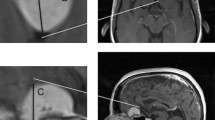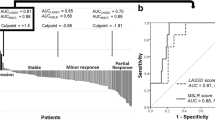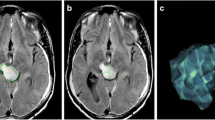Abstract
Purpose
To compare the accuracy of three volumetric methods in the radiological assessment of meningiomas: linear (ABC/2), planimetric, and multiparametric machine learning-based semiautomated voxel-based morphometry (VBM), and to investigate the relevance of tumor shape in volumetric error.
Methods
Retrospective imaging database analysis at the authors’ institutions. We included patients with a confirmed diagnosis of meningioma and preoperative cranial magnetic resonance imaging eligible for volumetric analyses. After tumor segmentation, images underwent automated computation of shape properties such as sphericity, roundness, flatness, and elongation.
Results
Sixty-nine patients (85 tumors) were included. Tumor volumes were significantly different using linear (13.82 cm3 [range 0.13–163.74 cm3]), planimetric (11.66 cm3 [range 0.17–196.2 cm3]) and VBM methods (10.24 cm3 [range 0.17–190.32 cm3]) (p < 0.001). Median volume and percentage errors between the planimetric and linear methods and the VBM method were 1.08 cm3 and 11.61%, and 0.23 cm3 and 5.5%, respectively. Planimetry and linear methods overestimated the actual volume in 79% and 63% of the patients, respectively. Correlation studies showed excellent reliability and volumetric agreement between manual- and computer-based methods. Larger and flatter tumors had greater accuracy on planimetry, whereas less rounded tumors contributed negatively to the accuracy of the linear method.
Conclusion
Semiautomated VBM volumetry for meningiomas is not influenced by tumor shape properties, whereas planimetry and linear methods tend to overestimate tumor volume. Furthermore, it is necessary to consider tumor roundness prior to linear measurement so as to choose the most appropriate method for each patient on an individual basis.



Similar content being viewed by others
Data availability
The datasets generated during and/or analysed during the current study are available from the corresponding author on reasonable request.
References
Gritsch S, Batchelor TT, Gonzalez Castro LN (2022) Diagnostic, therapeutic, and prognostic implications of the 2021 World Health Organization classification of tumors of the central nervous system. Cancer 128:47–58. https://doi.org/10.1002/cncr.33918
Ogasawara C, Philbrick BD, Adamson DC (2021) Meningioma: a review of epidemiology, pathology, diagnosis, treatment, and future directions. Biomedicines 9:319. https://doi.org/10.3390/biomedicines9030319
Opalak CF, Parry M, Rock AK et al (2019) Comparison of ABC/2 estimation and a volumetric computerized method for measurement of meningiomas using magnetic resonance imaging. J Neuro-Oncol 144:275–282. https://doi.org/10.1007/s11060-019-03205-z
Fountain DM, Soon WC, Matys T et al (2017) Volumetric growth rates of meningioma and its correlation with histological diagnosis and clinical outcome: a systematic review. Acta Neurochir 159:435–445. https://doi.org/10.1007/s00701-016-3071-2
Goldbrunner R, Stavrinou P, Jenkinson MD et al (2021) EANO guideline on the diagnosis and management of meningiomas. Neuro-Oncology 23:1821–1834. https://doi.org/10.1093/neuonc/noab150
Huang RY, Unadkat P, Bi WL et al (2019) Response assessment of meningioma: 1D, 2D, and volumetric criteria for treatment response and tumor progression. Neuro-Oncology 21:234–241. https://doi.org/10.1093/neuonc/noy126
Xue W, Vegunta S, Zwart CM et al (2017) Retrospective validation of a computer-assisted quantification model of intracerebral hemorrhage volume on accuracy, precision, and acquisition time, compared with standard abc/2 manual volume calculation. AJNR Am J Neuroradiol 38:1536–1542. https://doi.org/10.3174/ajnr.A5256
Chang V, Narang J, Schultz L et al (2012) Computer-aided volumetric analysis as a sensitive tool for the management of incidental meningiomas. Acta Neurochir 154:589–597. https://doi.org/10.1007/s00701-012-1273-9
Zeidman LA, Ankenbrandt WJ, Du H et al (2008) Growth rate of non-operated meningiomas. J Neurol 255:891–895. https://doi.org/10.1007/s00415-008-0801-2
Emerton BC, Jerram M, Deckersbach T et al (2009) A comparison of voxel-based morphometry and volumetry methods in the context of the neural basis of aggression. Brain Imaging Behav 3:332–341. https://doi.org/10.1007/s11682-009-9075-2
Avants B, Tustison NJ, Song G (2009) Advanced normalization tools: V1.0. Insight J. https://doi.org/10.54294/uvnhin
Yushkevich PA, Piven J, Hazlett HC et al (2006) User-guided 3D active contour segmentation of anatomical structures: Significantly improved efficiency and reliability. Neuroimage 31:1116–1128. https://doi.org/10.1016/j.neuroimage.2006.01.015
Uthus L, Hoff I, Horvli I (2005) Evaluation of grain shape characterization methods for unbound aggregates. In: Proceedings of the International Conferences on the Bearing Capacity of Roads Railways and Airfields
Lin NU, Lee EQ, Aoyama H et al (2015) Response assessment criteria for brain metastases: proposal from the RANO group. Lancet Oncol 16:e270–e278. https://doi.org/10.1016/S1470-2045(15)70057-4
Wen PY, Macdonald DR, Reardon DA et al (2010) Updated response assessment criteria for high-grade gliomas: response assessment in neuro-oncology working group. J Clin Oncol 28:1963–1972. https://doi.org/10.1200/JCO.2009.26.3541
Hunter JB, Yawn RJ, Wang R et al (2017) The natural history of petroclival meningiomas: a volumetric study. Otol Neurotol Off Publ Am Otol Soc Am Neurotol Soc Eur Acad Otol Neurotol 38:123–128. https://doi.org/10.1097/MAO.0000000000001260
Krumbein WC (1941) Measurement and geological significance of shape and roundness of sedimentary particles. SEPM J Sediment Res. https://doi.org/10.1306/D42690F3-2B26-11D7-8648000102C1865D
Laukamp KR, Thiele F, Shakirin G et al (2019) Fully automated detection and segmentation of meningiomas using deep learning on routine multiparametric MRI. Eur Radiol 29:124–132. https://doi.org/10.1007/s00330-018-5595-8
Laukamp KR, Pennig L, Thiele F et al (2021) Automated meningioma segmentation in multiparametric mri : comparable effectiveness of a deep learning model and manual segmentation. Clin Neuroradiol 31:357–366. https://doi.org/10.1007/s00062-020-00884-4
Huang RY, Wen PY (2016) Response assessment in neuro-oncology criteria and clinical endpoints. Magn Reson Imaging Clin N Am 24:705–718. https://doi.org/10.1016/j.mric.2016.06.00
Funding
The authors declare that no funds, grants, or other support were received during the preparation of this manuscript.
Author information
Authors and Affiliations
Contributions
Study conception and design were performed by JdSS, LdL, CDW, MAA, and ACG. Material preparation and data collection were performed by JSS, LdL, CDW, LM, JA, and MAA. Data analysis was performed by JdosSS, CAS, LL, and CEPLB. Statistical analyses were performed by JdSS, CAS, and MAA. The first draft of the manuscript was written by JdSS and CAS, and all authors commented on previous versions of the manuscript. All authors read and approved the final manuscript.
Corresponding author
Ethics declarations
Competing interests
The authors declare that they have no relevant financial or non-financial interests to disclose.
Additional information
Publisher's Note
Springer Nature remains neutral with regard to jurisdictional claims in published maps and institutional affiliations.
Supplementary Information
Below is the link to the electronic supplementary material.
11060_2022_4127_MOESM1_ESM.tiff
Supplemental Figure 1. Multiparametric visualization of a frontoparietal meningioma and surrounding structures. Vessels enhance on contrast-enhanced T1-weighted image and could be otherwise interpreted as tumor tissue (red arrow). This effect is corrected for with inclusion of T2-weighted and FLAIR images, which reveal the flow void sign in the vessel (black arrows). Taken together, information from all pulse sequences contribute to the identification, delineation, and correct labeling of tumor tissue (blue overlay). (TIFF 110081 kb)
Rights and permissions
Springer Nature or its licensor holds exclusive rights to this article under a publishing agreement with the author(s) or other rightsholder(s); author self-archiving of the accepted manuscript version of this article is solely governed by the terms of such publishing agreement and applicable law.
About this article
Cite this article
dos Santos Silva, J., Schreiner, C.A., de Lima, L. et al. Volumetric measurement of intracranial meningiomas: a comparison between linear, planimetric, and machine learning with multiparametric voxel-based morphometry methods. J Neurooncol 161, 235–243 (2023). https://doi.org/10.1007/s11060-022-04127-z
Received:
Accepted:
Published:
Issue Date:
DOI: https://doi.org/10.1007/s11060-022-04127-z




